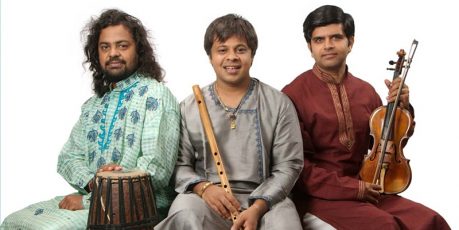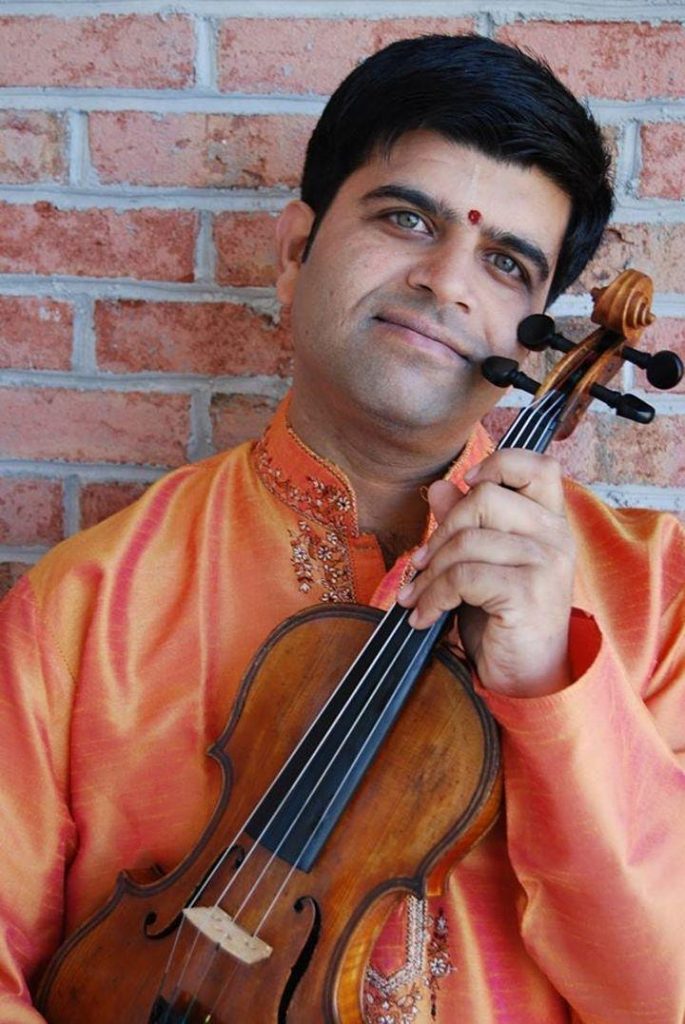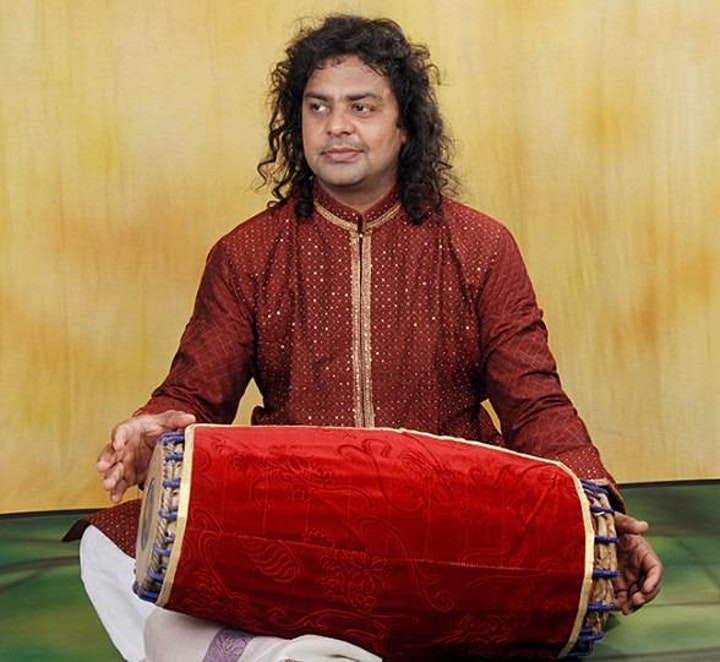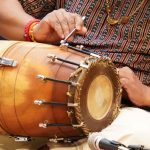Your cart is currently empty!

Carnatic Flute Concert (In-person event)
By Vidwan Shashank Subramanyam
Saturday, April 23, 2022 | 4:30PM
Fugett Middle School Auditorium
500 Ellis Lane
West Chester, PA 19380
About This Event
Please see Sruti COVID-19 guidelines before purchasing the tickets.
Carnatic Flute Concert by Vidwan Shashank Subramanyam, accompanied by Mysore Srikanth on the violin and Patri Satish Kumar on the Mridangam.
Shashank Subramanyam (Flute)
Child prodigy, Shashank amazed the public from the age of six in 1984, shortly after the death of the legendary TR Mahalingam alias Mali, genius and innovator of the Carnatic flute who had predicted a great future for him.
Formed in the greatest tradition by father Subramanyam, Palghat K.V. Narayanaswami, one of the greatest singers of the last century, Shashank has a vast repertoire and has never ceased to evolve and innovate. Known for several noteworthy contribution, he varies the tones by use of multiple flutes of various sizes using transposed fingering techniques. Already unique in this, he goes even further by incorporating the Hindustani music that he studied with the great singer Pandit Jasraj. His incredible sound and his consummate art of improvisation make him the most astonishing flautist of South India.
Among the many coveted awards bestowed, Grammy nomination for the CD album with Guitarist John McLaughlin, Sangeet Natak Akademi Award by the President of India and Kalaimamani by Govt of Tamil Nadu are noteworthy. He has presented concerts, workshops, lec-dems in prestigious concert halls, universities and conservatories, in over 50 countries. He has 80 CDs and several DVDs to his credit. More info can be found on www.shashank.org and social media pages.
Mysore Srikanth (Violin)
Mysore Srikanth is an A Grade artist of All India Radio and belongs to the Parur Violin Parampara. He is a senior disciple of Vidwan Sri. H.K. Narasimhamurthy of Mysore. He started learning violin at a very young age and has undergone rigorous training for more than twenty years.
Srikanth has been giving performances since age 15. He has gained rich experience by accompanying stalwarts like R.K.Srikantan, Dr.M.Balamuralikrishna, T.N.Seshagopalan, T.V.Sankaranarayanan, O.S.Thiagarajan, Trichur Ramachandran, Hyderabad Brothers, Yesudas, K.S.Gopalakrishnan, Rudrapatnam Brothers, Bombay Sisters, Sudha Raghunathan & others and received their blessings and appreciation. He has performed with great mridangam stalwarts like Palghat Sri Raghu, T.K.Murthy, Guru Karaikkudi Mani, Guruvayur Dorai, Vellore Ramabhadran, Umayalpuram Sivaraman, Tiruvarur Bhaktavatsalam, Srimushnum Raja Rao and many others. He is also performing with talented young artists like Abhishek Raghuram, Shashank and Sikkil Gurucharan. Srikanth has been featured in all prestigious Music Sabhas & Organizations throughout the country.
Patri Satish Kumar (Mridangam)
The much sought after mridangam artiste, Patri Satish Kumar was born into a family of musicians. He was initiated into the art of percussion by his mother Padmavathy, a renowned violinist at the age of 7. Trained under Gurus Sree Ramachandramurthy, V.A. Swami and V. Narasimhan, Satish Kumar continues to evolve a distinct style of his own. A fine performer and composer with a deep interest to innovate and explore the art form, his specialization is his precise fingering technique and the fine balance between the treble and base heads of the mridangam.
Satish Kumar has been a regular feature in prestigious venues and festivals in India and around the world including the Music Academy in Chennai, the Royal Albert Hall in London, at festivals in Paris, Spain and Canada.



Concert Review 1
Shashank’s Flute Concert – Another Perspective
By Jayaram Sataluri
Live at Fugett Middle School, West Chester, PA (Sruti concert- April 23rd 2022)
Shashank Subramaniam- flute
Mysore Srikanth- violin
Patri Satish Kumar- mridangam
Duration: approximately 2 hours 20 mins
Audience: Approximately 100 rasikas
1) sAmi ninnE kOri- Sri, Adi, Karur Devudu Iyer
2) ninnADanEla- kannaDa, dESAdi, Thyagaraja
3) ardha nArISvaram – kumudakriyA, rUpakaM, Dikshitar
4) suma sAyaka- karnATaka kApi, rUpakaM (2 kalai), Swathi Thirunal
5) Dual rAgam RT (kAmbhOji & vAgadhISvari)
a. kAmbhOji (w/ rAgamAlikA- hindOLaM, kEdAra gauLa, bEgaDa, aThANa) pallavi (about Muruga)- mISra CApu w/ swarams in kAmbhOji)- followed by 2 to 3 min thani by Patri
b. vAgadhISvari pallavi (same line as kAmbhOji)- Adi w/ rAgamAlikA swarams (pantuvarALi, bAgEshri, haMsadhvani, mOhanam, hindustAni tODi) followed by 4 to 5 min thani by Patri
6) rAma nAmamE- dESh, Adi, Thanjavur Sankara Iyer
7) vEnkaTAcala nilayam- sindu bhairavi, Adi, Purandaradasara
This was my first live Shashank concert although I had listened to him throughout the years. He, Mysore Srikanth and Patri Satish Kumar teamed up to deliver a solid start to the 2022 Sruti season which all rasikas joyfully lapped up. The stage was set up differently this time as Mysore Srikanth was to Shashank’s right (our left) and Patri was to his left (our right), but was facing the audience at an angle, which helped us enjoy the intricacies of his mridangam playing on both sides.
Shashank thanked Sruti for organizing the concert and was happy he was performing in Philadelphia after a long while. He started off with a short Sri ragam alapana in G sruti and announced that he would render the varnam. He started at 1 ½ speed and brought out the ragam’s beauty in the pallavi. When he needed to take a break, he let Mysore Srikanth take charge. After the mukthayi swaram, he repeated in 3rd speed and displayed his mastery. After the pallavi, he played 2nd speed for the charanam and the ettugada swarams twice. He ended with a tara sthayi shadja and Patri finished with a small theermanam.
Then Shashank played a short Kannada ragam alapana where he and Mysore Srikanth focused on the different variations of the ragam. He then announced he would render Ninnadanela and did justice to Thyagaraja’s krithi by playing the usual sangatis that we’ve heard before. But it was the swaraprastara where he shined brightly by combining both mathematics and musicality much to Patri’s glee. For the shorter portions, he would end at the ring finger. The audience enjoyed it immensely.
After the captivating Kannada, Shashank gave us two choices of ragams: Sriranjani or Kumudakriya. We chose the latter and Shashank delved into exploring each facet of the ragam and brought different dimensions which I wouldn’t have paid attention to earlier. He switched flutes in between. He would bounce between the different notes and at one point I thought I could hear a grahabhedam somewhere. His faster taans were brilliant. After his alapana, Shashank announced the raga’s name, what janya raga it was based off of and its characteristics (no panchama and kaakali nishada in the arohanam, but there is kaakali nishada in the avarohanam). As we’re all aware, there is only one krithi in Kumudakriya, Dikshitar’s Ardhanareeshwaram and Shashank said he would render it. Mysore Srikanth provided a short response which contained the Parur stamp and maintained the solemn mood throughout. The trio then proceeded to render the krithi with serenity and divine bhavam. One could say that the image of Ardhanareeshwaram was vividly visualized by the trio. The charanam especially was charming and I liked how Shashank switched from the small piccolo type flute to the bigger bambooish flute. I’m not too sure if there was a neraval, but the Kumudakriya swarams were entrancing. One just couldn’t get enough of them.
Next was Suma Sayaka, one of my favorite Swathi Thirunal krithis and it was wonderful to hear it once again. It brought back memories of listening to recordings of KVN render this with such profundity. And Shashank definitely would have made his late guru proud. He played the swara sahityas twice and made sure they sounded different each time. The Ragamalika was exquisite as always and the trio were in sync. Patri’s radiant gumkis stood out. Shashank mentioned it was one of KVN’s signature songs that he formally learnt and it was the first time he had played it in decades; he humbly said that he hoped he did justice to it.
Shashank asked us if we wanted to hear Kambhoji or Vagadeeshwari. At first, most of the audience said the latter whereas some wanted the former. But there were a few people (including yours truly) who wanted both and we declared “Both!” out loud. With a smile, Shashank said 50-50 and played a familiar permutation of notes which defined both the ragams; he announced the same to which the audience broke into laughter. Then he proceeded to highlight Vagadeeshwari in the mandra and madhya sthayis and made sure to emphasize Shatsruthi Rishabham. He ended on the tara sthayi and let Mysore Srikanth take over where the violinist responded resplendently by echoing whatever Shashank did and alternating between slow and faster gamakas. When he finished at the tara sthayi, Shashank took over and made a clean transition from Vagadeeshwari to Kambhoji and highlighted the raga in the tara sthayi. He was also playing chords on the flute which made it sound more Western like and bounced between notes during the faster taans. He made another clean transition to the tanam and easily adjusted between the two ragams during each turn. I especially enjoyed when he played kanda gathi in the faster kalams. Mysore Srikanth’s responses were subdued yet impressive and he did not falter a bit.
After the tanam, Shashank said although both ragams could be rendered together in equal measure, it would be hard for some of the listeners to differentiate between the two. Therefore, he would render two pallavis: the first would be Kambhoji in Misra Chapu Talam (started at samam) with a pallavi dedicated to Muruga which he sang (I don’t remember the pallavi line) and the second one would be the same pallavi line in Vagadeeshwari this time in Adi talam (started at samam). He then played the Kambhoji pallavi in Misra Chapu. In the same pallavi line, he did a Ragamalika for each turn with Mysore Srikanth responding each time. Then he returned to Kambhoji and played the pallavi a few more times before proceeding with the swarams without doing trikalam. Like he did with the Kannada swarams, he did algebraic calculations in the shorter swarams and made them sound beautiful. He let Patri play a short Misra Chapu thani and the enthusiasm of the vidwan was infectious. He played misra gathi briefly and he played an electrifying korvai in 2 speeds which kept us on our toes; Shashank joined during the last turn of the faster speed.
Then Shashank quickly started Vagadeeshwari in Adi talam and played the pallavi line a few times without going into trikalam. He went into the shorter swarams and did Ragamalika for each turn by making sure we were able to identify each of the ragams’ phraseology, although the last ragam was a bit tricky to identify. But the swaram finish was stupendous. Patri did slip up a bit towards the end, but made it up with a 4 to 5 min thani where he displayed his speed and control. His kanda gathi was wonderful and his farans, mohara and korvai were terrific. Like always, he picked up the pallavi line in his korvai much to the delight of Shashank who complemented him with his fast taans as Patri finished the pallavi with rousing thunder.
After the tremendous finish of the Vagadeeshwari pallavi and an applause session that lasted 15 to 20 seconds, Shashank proceeded with Thanjavur Sankara Iyer’s Rama Namame and the trio went into the bhakti mode. It sounded so heavenly and the grace of Sri Rama appeared in my mind and I murmured His name silently. Next was a short but sublime Sindhubhairavi alapana where Shashank brought out Hindustani pidis and played Venkatachala Nilayam. The bhakti mode was still intact and everyone was in bliss. Just when we thought he would play a thillana or mangalam, Shashank announced the concert was over much to our surprise. Yet we rose up and applauded the trio fervently.
Shashank was in command and displayed his brilliance all around. I was happy he played rare ragams like Kannada, Kumudakriya and Vagadeeshwari, because we wouldn’t have heard such unique and shining displays of each ragam. Although I wish he had rendered a dual RTP, he didn’t disappoint with 2 separate ones. He combined purity and dexterity and delighted us all. He is on his way to become one of the legends of Bharatiya Sangeetham and we need to encourage him further
Mysore Srikanth was at his supportive best. The Parur school was alive inside him (which I told him after the concert) and one felt the presence of MSG in the auditorium. His responses to Shashank were appreciable where he was able to exhibit the finer attributes of the Parur school. His nimbleness was exceptional and his staccato side was splendid. I had heard him in recordings but never saw him live and was glad to see him.
This is the 5th time I have seen Patri live and he never ceases to amaze. This wizard is already a legend as far as I’m concerned. Layam reverberates from his entire body and soul. His beaming smile, inexhaustible joyfulness and 100% concentration and involvement in the concert is always a sight to behold. He is always in the moment and always enriches every concert he’s in. Though his mic is on the higher side, his style which contains a lot of gumki and some tabla phraseology is just magical. I joked to him that it would have been great to have a dual RTP in Panchamukhi Adi talam which he would have aced with flying colors!
The trio was humble and thankful that they got to perform in Philadelphia. They were benevolent to take photos with the audience members at the end of the concert.
Overall, it was a wonderful start to a promising Sruti 2022 season and the rasikas couldn’t stop appreciating what the trio delivered. The 2022 season has started with a bang and looking forward to the upcoming concerts this season! the higher
Jayaram Sataluri is an ardent fan of Sruti.
Concert Review 2
Delightful Flute concert by Shashank
By Harish Bevinahally
It was great to see our SRUTI music community come together for Shashank Subramanyam’s first in-person concert after two seasons of virtual concerts due to the COVID pandemic. Shashank gave a masterful performance at the Fugett Middle School auditorium in West Chester to kick-off the 2022 concert season.
Shashank opened the concert with Saami Ninne Kori varnam in Sri raga and performed with amazing speed and precision. Shashank followed this with a beautiful rendering of Ninnada Nella (Saint Thyagaraja composition) in Kannada. This kriti brought fond memories of late N. Ramani playing this composition. Shashank played the swaraprasthara with a touch of Hindustani mukthaayas, a reminder of his proficiency in both classical forms.
For the next composition, Shashank offered a choice of ragas, Kumudakriya or Sriranjani, and the erudite SRUTI audience selected Kumudakriya. This raga (janya of Panthuvarali) without the panchama, offers a unique melody, but also presents challenges to a flutist while playing the gamakas. Shashank’s rendering of alapana and Dikshitar’s Ardhanaareeshwaram was graceful. Mysore Srikanth on the violin played Kumudakriya beautifully, inspired by the late maestro Parur MS Gopalakrishnan. Shashank next played his guru KV Narayanaswamy’s favorite song Suma Sayaka (a Swathi Thirunal kriti in Karnataka Kapi). Shashank had not played this piece in a while but performed with poise and demonstrated breathing technique that brought out the essence of KVN’s vocal music on the flute.
Next item was Raga-Thanam-Pallavi (RTP) in two ragas (Vagadheeshwari and Kambhoji) upon request from the audience, who could not decide on one! The first part was in Kambhoji, set to Mishra chaapu, followed by a brilliant thani avarthanam on the mridangam by Pathri Satish Kumar. Second part of the RTP was in Vagadheeshwari, set to Adi. Vagadheeshwari is a melakartha raga, and Shashank took the audience on a soulful journey (Saint Thyagaraja composed a deeply contemplative song, Paramatmudu, in this raga). Second part of the RTP was followed by another delectable thani avarthanam by Satish Kumar. Shashank treated the audience to melodious ragas and impressive swaraprastharas in the RTP, with capable support from Srikanth and Satish Kumar. Shashank concluded the concert with a bhajan in Desh raga, followed by my mother’s favorite song, Venkatachala Nilayam (Purandaradasa kriti for Lord Venkateshwara) in Sindhubhairavi.
Shashank used four flutes and switched them to cover multiple octaves. He used the lower octave flute for the most part and switched to shorter flutes (for higher octave) or longer flute (for the base octave). I would have preferred that he played on the higher octave for the main concert performance. He has mastered the technique of switching flutes (introduced by the flute maestro late N Ramani) to transpose swaras for smooth transition. Shashank also used novel breathing, tongue, and fingering techniques to produce blended octaves, crisp staccato, and vibrations. His gamakas were superb, rooted in vocal training, and his grip on rhythm (laya) was outstanding.
Harish Bevinahally is a Carnatic music flautist and has been a long time supporter and admirer of Sruti.









